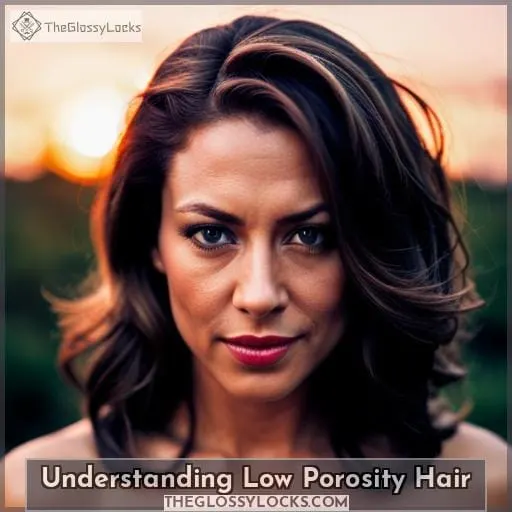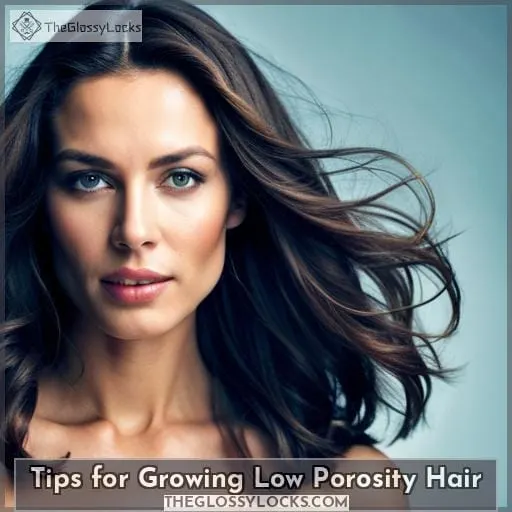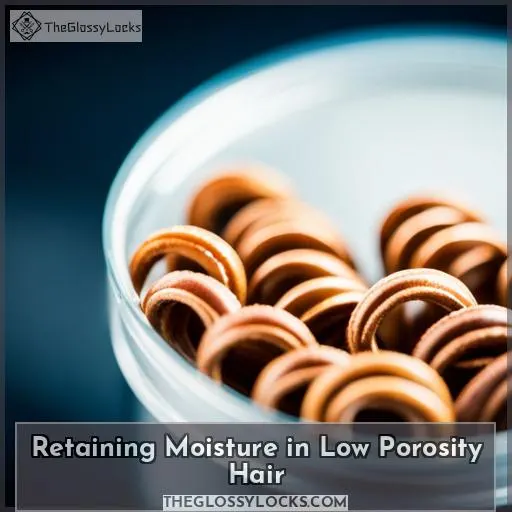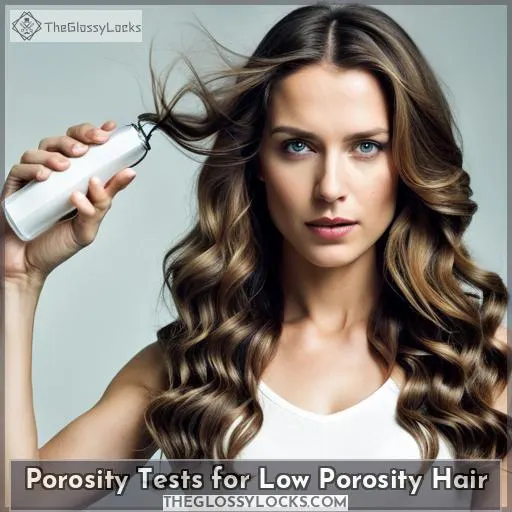This site is supported by our readers. We may earn a commission, at no cost to you, if you purchase through links.
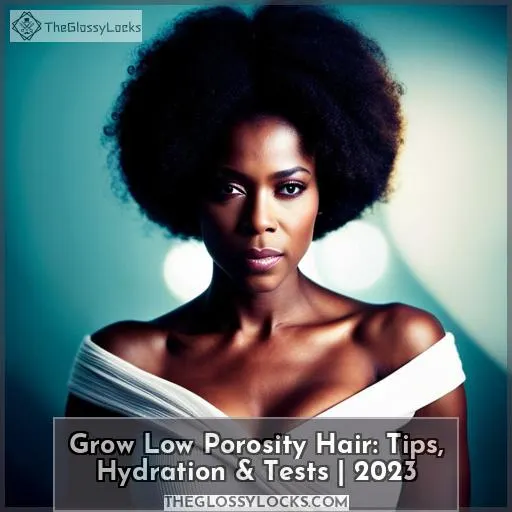
But don’t worry — if your strands are struggling with hydration, there’s hope yet! With the right techniques for maximizing hydration in your curls (and avoiding common mistakes), you can help them thrive like never before.
Read on for all the information you need about understanding low porosity hair; plus tips for growing long locks that stay healthy and moisturized throughout their journey towards length retention success.
Table Of Contents
Key Takeaways
- Genetics and inherited tight cuticles can cause low porosity hair.
- Low porosity hair resists moisture and has difficulty absorbing products.
- Maintaining clean hair and using water-based stylers can help with moisture absorption.
- Deep conditioning regularly and using the L.O.C. method can help retain moisture in low porosity hair.
Understanding Low Porosity Hair
If you have low porosity hair, you may already be aware of the unique characteristics and causes associated with it. Low porosity hair has a tight cuticle, which results in water beads sitting on the surface rather than being absorbed into the strands.
It is resistant to absorbing moisture and can become easily damaged or dry if not properly cared for. Understanding how to care for your low porosity hair is key to encouraging healthy growth and avoiding breakage over time.
Characteristics of Low Porosity Hair
If you’ve noticed water beads on your hair and products sitting on top instead of absorbing, you may have low porosity hair that resists moisture retention. It’s vulnerable to dryness and breakage due to tight cuticles that won’t open up easily.
To keep it healthy, use the LOC method with light oils; balance protein treatments with deep conditioning; pre-poo before washing; use a spray bottle for daily hydration; avoid direct high heat when styling.
Causes of Low Porosity Hair
You’re probably wondering why your mane isn’t the lush, bouncy locks you see on TV – it’s likely due to your low porosity hair! Low porosity is caused mainly by genetics and inherited tightness of cuticles.
To prevent dryness, keep up with regular cleansing and conditioning while avoiding heavy proteins that are hard for strands to absorb. Hair vitamins like biotin can help nourish from within while protective styles such as braids or wigs retain length without extra damage.
Tips for Growing Low Porosity Hair
Growing low porosity hair can be a challenge, but with proper care and maintenance, it is possible. Keeping the hair clean and free from product buildup is essential to allow moisture absorption. Using water-based stylers instead of oil-based ones will help maintain hydration, while deep conditioning with intention will replenish nutrients in the strands.
Lastly, protein should only be used strategically as too much can cause damage to this delicate type of hair.
Keeping the Hair Clean
To keep your hair healthy and hydrated, make sure to cleanse it thoroughly with a quality shampoo. Moisturizing properly is key for low porosity hair; use lightweight oils or conditioners that won’t weigh down the strands.
Pre-pooing before washing helps clarify the scalp and remove buildup while detangling at the same time.
Clarifying regularly is also important to ensure no product residue remains on your locks.
Using Water-based Stylers
Try adding lightweight, water-based stylers to your routine for an extra boost of hydration and shine!
To do this correctly, perform the slide test: run a strand of hair between two fingers. If it slides easily without breaking or snagging, you know that you’re moisturizing correctly.
For a pre-poo/moisturizer, try rice water; its proteins are limited but enough to nourish hair without product buildup.
Also, use steam treatments with satin bonnets once every three weeks for added strength and hydration.
In addition, try protective styles at night to help retain length and keep strands safe from breakage caused by friction against bedding materials like cotton pillowcases.
Now, start styling with healthy low porosity curls!
Deep Conditioning With Intention
Regularly deep conditioning with intention can help nourish and strengthen your low porosity hair – why not give it a try?
Wet the hair before applying heat styling, as this helps prevent breakage. Use oils to seal in hydration and add shine.
For extra internal nourishment, opt for deep conditioners with biotin or other vitamins. Avoid products that lather too much; they strip away natural oils from the scalp, which is important for regrowth strategies.
Leave-in conditioner also helps keep strands afloat while wet – an essential factor of low porosity locks!
Hydration hacks like steaming are great for achieving maximum moisture absorption without any direct high heat damage on fragile ends.
Take advantage of these tips today and watch your mane thrive!
Using Protein Strategically
Use protein-based products sparingly, as too much can weigh down your locks and prevent moisture absorption. When styling low porosity hair, use light proteins like amino acids or silk to help strengthen the cuticle layer without weighing it down.
Supplement with natural oils for extra hydration and detangle using heatless pre-pooing methods such as finger combing or wet brushing before shampooing. Additionally, consider adding vitamins to your routine, which may help promote healthy growth of low porosity strands while avoiding heavy oils that can build up on the hair over time.
Retaining Moisture in Low Porosity Hair
Welcome! Maintaining low porosity hair can be a challenge, but with the right routine and products, you can keep your strands hydrated.
Keeping Strands Hydrated
Moisturize your mane with natural oils and water-based products to keep strands hydrated. Try low heat styling methods like hooded dryers or steaming, which penetrate the cuticle without damaging it. Supplementing with hair vitamins can also help nourish from within. Consider protective styles such as braids or wigs to retain length and protect ends from damage.
A strand test followed by a spray test will reveal how well your locks absorb moisture – look out for signs like water beading on strands or difficulty absorbing product; these are indicators of low porosity hair that needs extra TLC! To finish off, spritz aloe vera onto dampened tresses after showering for an immediate boost of hydration.
Using the L.O.C. Method
To keep low porosity hair hydrated, employ the L.O.C. method to lock in essential moisture and ensure healthy-looking strands. Use a light oil like rice water or coconut to protect from ambient heat. Follow with a butter for added protection.
Add steam treatments and a bonnet dryer with low heat if possible. Take hair vitamins that include biotin for internal nourishment.
Clarifying the Hair
To ensure your hair gets the moisture it needs, periodically give it a deep clean with clarifying products. Clarifying benefits low porosity hair by removing product buildup and environmental impurities that can block moisture absorption.
Porosity treatments like this also nourish the scalp for optimal hydration, promoting healthy growth and protecting against breakage.
When selecting a product, look for natural ingredients to refresh your locks without stripping away precious oils or causing dryness in already fragile strands.
With careful selection of appropriate products tailored towards providing balance between cleansing and conditioning, you’ll be giving yourself the best chance at having strong, healthy natural hair porosity!
Going Easy on Protein
Protein can weigh down your locks, so try to keep it light for maximum moisture. Consider using protein-free conditioners and following the L.O.C method of layering with liquid, followed by oil and cream, to retain length without heavy butters or oils that may lead to product build-up on low porosity hair strands.
To test if a product has too much protein, use the slide test. Run a strand between two fingers. If it doesn’t move smoothly, there is too much protein in them! Affordable solutions like Aussie Miracle Moist Conditioner provide essential nourishment while restoring vibrancy and color depth.
It also allows deeper cuticle penetration for more hydration retention than traditional shampoos alone could provide.
So get creative with finding ways of retaining moisture without weighing down your precious locks!
Trying a Pre-Poo
Try pre-pooing your hair before shampooing to give it an extra burst of hydration – you’ll be amazed at the difference! Pre-poos help protect low porosity hair from damage, while also providing moisture.
Benefits include:
- Smoothing strands with natural oils and butters like coconut oil and shea butter.
- Replenishing nutrients by using hydrating ingredients such as honey or aloe vera juice in a pre-poo mix.
- Applying styler over the sink instead of directly on the scalp for better distribution without buildup.
- Using thicker gels to lock in long-lasting moisture before styling.
All these tips can help you retain more moisture, resulting in healthier-looking locks that are easier to grow out! Experiment with different recipes tailored for specific needs so you can find what works best for your own unique mane – just don’t forget the power of the pre-poo!
Maximizing Hydration in Low Porosity Hair
Are you looking for the best way to maximize hydration in your low porosity hair? Moisturizing properly, utilizing light oils that are easily absorbed, deep conditioning with heat, and using rice water can all be effective strategies when it comes to hydrating low porosity hair.
Moisturizing Properly
Replenish your strands with the right products and keep them hydrated for healthy, gorgeous hair! Moisture retention is key to keeping low porosity hair looking beautiful. Protective styling can help retain that moisture while biotin supplements and other vital vitamins strengthen from within.
Steam treatments are also very beneficial when it comes to hydrating strands without overloading them with product or unnecessary oils.
Using Light Oils That Are Easily Absorbed
Lightweight oils, such as avocado and jojoba seed oils, are easily absorbed into low porosity hair to lock in moisture and improve hydration. Aussie Miracle Moist Conditioner is infused with both of these hydrating oils to deeply nourish and hydrate dry hair while adding a pleasant citrus scent.
To maximize the benefits for low porosity hair, use water-based products over heavy proteins. Incorporate steam treatments and take biotin supplements for internal nourishment. Additionally, pre-poo before washing – this will help open up the cuticle so that it can absorb more moisture.
With proper care, you’ll be able to keep your locks full of life!
Deep Conditioning With Heat
Give your hair a weekly deep conditioning treatment with heat to get the maximum hydration for soft, shiny strands. Use clarifying shampoos every few weeks to prevent product buildup that blocks moisture absorption.
When using heat protectant products, apply them generously and evenly before styling with hot tools. Alternatively, wrap damp hair in a satin scarf overnight for extra protection against dryness. Hair vitamins can also help promote healthy growth by providing essential nutrients internally, while keeping strands strong and resilient from damage due to excessive dryness or breakage.
Rice Water for Low Porosity Hair
Treat your low porosity hair to nourishing hydration with a rice water rinse, unlocking its hidden potential and making it shine like the stars! Rice water benefits include:
- Increased curl definition
- Improved moisture retention
- Enhanced hair growth for fuller locks.
Used regularly as part of your hair care routine, rice water can improve porosity levels while replenishing lost nutrients in heat-damaged strands – perfect for those who want stronger, more manageable curls without sacrificing length or softness! Get ready to discover a silky smooth texture that’s sure to make heads turn everywhere you go!
Porosity Tests for Low Porosity Hair
Assessing the porosity of your hair is essential for determining how to best care for it. There are three common tests to accurately measure low porosity: the sink/float test, spray bottle test, and slide test.
Each one helps you determine how likely your hair is to absorb moisture and products so that you can create a tailored routine based on your specific needs.
Sink/Float Test
Dip a strand of your hair into water to see if it sinks or floats – the Sink/Float Test – and you’ll determine porosity. This elasticity test also reveals curl pattern, protein sensitivities, and natural moisture levels.
A floating strand means low porosity as its cuticle layers lie flat against each other, repelling rather than attracting moisture; sinking indicates high porosity with looser cuticles that absorb more easily.
Spray Bottle Test
Spray your hair with water and see how long it takes to dry – that’s the spray bottle test for checking porosity! The amount of moisture retained in your strands can indicate whether you have low or high porosity.
Humidity protection is key, so look into vitamin supplements and curl definition products that’ll help prevent frizz. Air drying helps as well since heat from blow-dryers may damage delicate cuticles further.
Your routine should include a clarifying shampoo, deep conditioning treatments, lightweight oils for moisture retention, hooded dryers when setting styles instead of direct heat tools like curling irons and flat irons; plus satin head wraps at night if possible.
With regular trims to remove split ends plus protective styling techniques like braids or wigs for length retention, your journey towards healthy locks begins here!
Slide Test
Try the Slide Test to assess your hair’s porosity: slide a strand of hair between two fingers and observe how easily it slips. This can indicate water absorption capability, texture, and protein use needs. If it slides quickly with little resistance, this suggests lower porosity – meaning you should focus on hydration more than other aspects like heat styling or product buildup.
On the flip side, if there is significant friction when sliding, then higher porosity may be present, which requires heavier moisture retention as well as manipulating the cuticle layer with light proteins for optimal health.
Frequently Asked Questions (FAQs)
What is the best way to protect low porosity hair at night?
To protect low porosity hair at night, wrap it in a satin scarf or sleep on a satin pillowcase. These fabrics are softer and smoother than cotton, reducing friction to help keep your strands hydrated and healthy.
What are the best vitamins to take for low porosity hair growth?
For low porosity hair growth, vitamins like biotin and collagen are great. They help nourish the strands from within, promoting strength and shine while protecting against dryness and breakage.
How often should I trim my low porosity hair?
Trim your low porosity hair every 6-8 weeks to prevent split ends, retain length, and keep it healthy.
Does heat damage low porosity hair?
Yes, heat can damage low porosity hair. Use hooded dryers and avoid direct high temperatures to set styles and protect your strands from becoming brittle or breaking off.
Are there any styling techniques that are especially beneficial for low porosity hair?
Yes! Protective styles such as braids and wigs can help retain length, while hooded dryers with low heat are ideal for setting styles without damaging the hair. Use lightweight oils to lock in moisture and pre-poo before washing for the best results.
Conclusion
Wrapping up this journey to discovering how to grow low porosity hair, it’s time to take the lead and take action. Understanding the characteristics of low porosity hair and the causes of this hair type is the first step to establishing a healthy hair routine.
Following tips to keep the hair clean, deep condition with intention, and use protein strategically are key. Retaining moisture is a must with the L.O.C. method, clarifying products, and pre-poo. And finally, maximizing hydration with the right products, heat, and rice water can be life-changing for low porosity hair.
With a bit of trial and error, you can get your hair to a healthy, hydrated place that will give you the length and volume you desire. Now that you’ve taken the time to learn how to grow low porosity hair, you can rest assured that your hair will be its healthiest and happiest.

